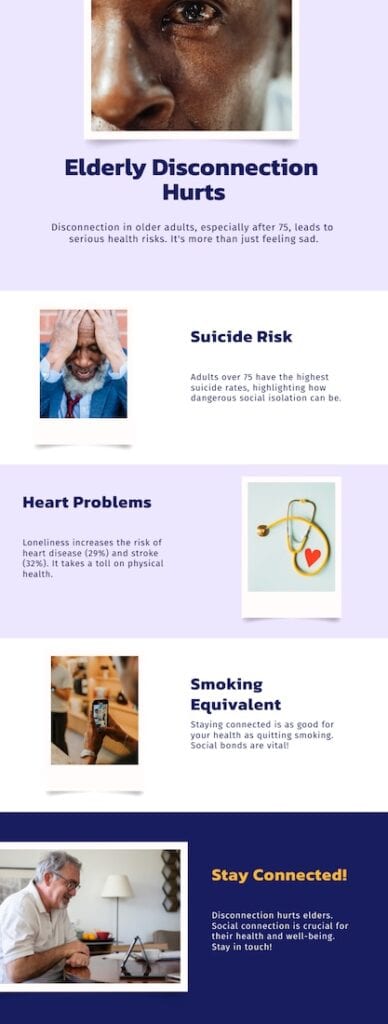How can we tackle loneliness and support senior mental health? There are a wide variety of options available to support seniors, such as Medicare IOP coverage, Friendship Lines, village networks, and smart-home companions.
Every Tuesday at 10 a.m., Maria Alvarez rests a cordless phone on her kitchen table and waits for Sam, a college volunteer she has never met in person. Their half-hour chat—about Dodgers scores, her late husband’s salsa recipes, the stray cat he rescued—has become Maria’s favorite medicine. She is part of a “social prescription” pilot that pairs older adults with weekly friendly-call volunteers, modeled on programs the U.S. Department of Veterans Affairs now runs in 70-plus communities.
The Hidden Dangers of Isolation
Loneliness is more than a mood. Among U.S. adults age 75 and older, suicide rates remain the nation’s highest—a stark reminder that social pain can be lethal. Chronic isolation also hammers the heart: long-term studies tie feeling lonely to a 29 percent jump in coronary heart-disease risk and a 32 percent rise in stroke. “Social connection is as protective as quitting smoking,” the Surgeon General noted in a 2024 advisory.

Medicare’s IOP Lift
For decades, Medicare covered only brief counseling in primary-care offices. As of January 2025, Part B now reimburses Intensive Outpatient Program (IOP) services—bundled group therapy, medication management, and case coordination delivered three to five days a week, including via rural health clinic. The expansion means an eighty-year-old battling depression no longer has to choose between full hospitalization and “check-back-next-month” visits.
Policy in Practice
- No inpatient stay required before enrolling in IOP.
- Deductible applies; after that, Part B covers 80 percent.
- Tele-IOP is billable when a clinician directs care in real time—critical for home-bound elders.
Grassroots Lifelines to Belonging
Federal agencies and grassroots groups are filling the social gaps doctors alone can’t reach.
- NIA Outreach Toolkit – Printable tip sheets and multilingual videos help families spark conversation and spot warning signs of isolation.
- Friendship Line – A 24/7 accredited crisis and warm line that handled more than 150,000 calls last year from adults sixty-plus.
These community webs knit purpose back into daily life—something no pill provides.
Smart Homes, Warmer Hearts
Silicon Valley is courting seniors with devices that do more than turn on lights. The AI-powered ElliQ robot now nudges users to walk, tracks sleep, and messages caregivers if routines slip. Amazon’s Alexa Together service lets distant relatives receive alerts when a loved one hasn’t asked for the weather by noon. While gadgets are no substitute for human touch, they can bridge silent hours between visits—especially for solo agers like Maria.
Five Small Moves to Reconnect
- Use your Medicare Part B mental-health benefits. Ask a primary-care doctor about IOP or tele-therapy options now covered.
- Call your Area Agency on Aging (AAA). Every U.S. county has one—dial 211 or visit ElderCare.acl.gov for meal sites, caregiver grants, and “Friendly Caller” rosters.
- Join a village network or senior center. Sliding-scale dues often include rides and tech coaching.
- Enroll in tech-literacy classes. Libraries and AAAs host free workshops on video chat and wearable safety buttons.
- Schedule social prescriptions. Ten minutes of planned conversation—in person, by phone, or via virtual book clubs—can reset mood and motivation for the day.
Opening the Door to Hello
If you or a loved one feels the walls closing in, reach out today—whether to a neighbor, a hotline volunteer, or your Medicare provider. Connection is treatable, and it starts with hello.
Senior Mental Health Care FAQs
Does Medicare really pay for mental-health group programs now?
Yes. Since January 1 2025, Medicare Part B covers Intensive Outpatient Program services when medically necessary. Beneficiaries typically attend structured therapy three or more days weekly; Part B pays 80 percent after the deductible, and supplemental plans may pick up the rest. Tele-IOP sessions qualify when led live by a licensed clinician.
How can I find a friendly-call volunteer program near me?
Begin with your local AAA or state Long-Term Care Ombudsman. Many partner with nonprofit phone-friend initiatives, senior centers, or faith groups. Veterans can enroll in the VA Compassionate Contact Corps, which pairs them with trained volunteers for weekly calls.
Are smart-home monitors safe for privacy?
Most devices keep audio data on-device or encrypt it in transit, but always review settings: mute “always-on” microphones when not needed, disable unsolicited marketing alerts, and create a household password your caregiver also knows. Subscription elder-care services like ElliQ or Alexa Together must follow HIPAA-aligned security standards if transmitting health data.
Does loneliness affect physical health even if I exercise and eat well?
Unfortunately, yes. Large meta-analyses show social isolation independently raises heart-disease risk by roughly 29 percent and stroke risk by 32 percent—similar to smoking fewer than five cigarettes a day. Stress hormones and inflammation likely play a role, so nurturing relationships is as vital as diet or movement.

